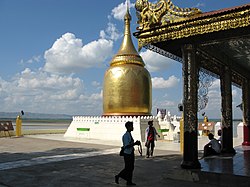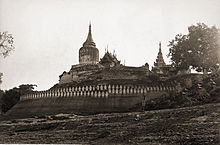204:
29:
276:
219:. As the pagoda is bulbous and in the shape of gourd or pumpkin, the word 'Bu' in Burmese, which means "pumpkin" or "gourd" is the affixed to 'paya'. The word 'paya' means "pagoda". It is also said that King Pyusawhti, builder of the Pagoda, got the river bank deweeded as it was infested with gourd-like plant, considered a 'menace'.
232:(at the location where the Bupaya Pagoda was built later). Subsequently, the then King pleased with the gallant act of Pyusawti gave him, as a reward, his daughter in marriage. Later, Pyusawti became the King of the region. During his reign, he built pagodas at each of the places where he had destroyed the 'Menaces'.
291:
However, the new Bupaya Pagoda built at the same location in 1976–78, after the earthquake, is a hollow reinforced concrete structure (replacing the traditional brick structure of the past). It has been built on the traditional plan of a polygonal base. The pagoda rises up in "a series of crenellated
283:
In keeping with the tradition of building pagodas in
Myanmar, the Bupaya Pagoda also conformed to the norms set for such structures. The pagoda had a massive gravity-type pyramidal profile. It was built with bricks and impressively decorated. It was a bell-shaped dome built over diminishing terraces.
263:
The dating of this pagoda has several versions. According to the earliest claimed historical records, the Bupaya Pagoda claimed as the oldest, was built in the 3rd century by the third king of Pagan, Pyusawdi, who ruled from 168 to 243 AD. However, it is also reported that the pagoda was commissioned
195:. As result of this earthquake, the bulbous pagoda broke into pieces and fell into the river. It was, however, fully reconstructed using modern materials, with lesser adherence to the original design. Subsequently, it was built as a gilded superstructure.
227:
According to a legend, Pyusawti who built this pagoda, as a young man defeated "Five Great
Menaces" that were detrimental to the interest of the city of Pagan. One of these five menaces was the extensive proliferation of the plant vines of
264:
in the 2nd century by King
Pyusawti. On the basis of similar pagodas and city walls built in Pagan, it has been conjectured that Bupaya Pagoda was built in the 9th century or even 11th century.
267:
However, the old pagoda getting destroyed completely and falling into the
Irrawaddy River during the 1975 earthquake, has indelibly scotched any arguments on the subject of its dating.
184:
who ruled from 168 to 243 AD. It is one of the most notable shrines among the thousands of new or ruined
Pagodas in Pagan, which is located about 90 miles (140 km) south of
660:. Department of Architecture, Rangoon Institute of Technology in co-operation with the Department of Archaeology, The Ministry of Culture and Finance. 1989. Archived from
248:), within the walled city of Pagan (a large capital city of the Burmese Kingdom between the 11th and the 13th centuries), over a series of
628:
83:
208:
520:
255:. The river takes a bend at this location. It acted as a guide landmark to navigators. It was built amidst a huge bush.
657:
582:
467:
330:
457:
285:
76:
684:
699:
176:. The small pagoda, which has a bulbous shaped dome, is widely believed to have been built by the third
605:
572:
430:
406:
378:
355:
320:
203:
550:
192:
636:
8:
252:
578:
463:
326:
28:
489:
275:
241:
216:
173:
156:
144:
297:
704:
161:
693:
661:
177:
98:
85:
658:"Tour Pagan: Bagan Buddhist Archaeological site, Ayeyarwaddy river, Myanmar"
249:
292:
semi-circular terraces overlooking the river". It is now fully gilded
181:
132:
245:
185:
55:
296:. The pagoda is now a very distinct landmark on the shores of the
215:
The name 'Bupaya' is made up of two words 'bu' and 'paya' in the
169:
69:
51:
279:
A new pagoda at the entrance to the main Bupaya Pagoda in Bagan.
455:
229:
165:
65:
521:"Pumpkin Pagoda [Bupaya Pagoda], Pagan, Upper Burma"
570:
411:. Supdt., Govt. Printing and stationery. 1960. p. 10
490:"The Ancient Mon-, Pagan,Peru and nakoran Pathom"
207:Original Pagoda as seen in 1868 destroyed in the
691:
456:Falconer, John; Luca Invernizzi Tettoni (2000).
360:. Burma. Archaeological Survey. 1963. p. 29
284:A finial crowned the dome. The pagoda enshrined
607:The temples and sculpture of Southeast Asia
574:The jade window: images from Southeast Asia
571:Herman, Maya; Maja Herman-Sekulić (1998).
451:
449:
408:Amended list of ancient monuments in Burma
380:Imperial gazetteer of India ..., Volume 19
545:
543:
541:
539:
537:
191:The original pagoda was destroyed in the
650:
603:
597:
515:
513:
511:
509:
314:
312:
274:
202:
446:
371:
350:
348:
240:The Pagoda is built on the edge of the
692:
564:
534:
401:
399:
397:
318:
506:
325:. Fielding Travel Books. p. 34.
309:
172:, at a bend on the right bank of the
155:
383:. Clarendon Press. 1908. p. 313
345:
244:(it is Myanmar's largest commercial
428:
394:
13:
621:
422:
14:
716:
678:
610:. Thames & Hudson. p. 57
462:. Tuttle Publishing. p. 27.
16:Buddhist Pagoda in Bagan, Myanmar
523:. British Library:Online Gallery
27:
685:MyanmarBagan Travel Information
577:. Suk's Editions. p. 120.
459:Burmese design and architecture
551:"Bupaya Temple (built c. 850)"
482:
1:
303:
495:. Sunzi Library. p. 181
270:
235:
198:
7:
319:Deland, Antoinette (1989).
118:2nd century or 11th century
10:
721:
258:
633:Bupaya Pagoda (Bu Pagoda)
222:
148:
127:
122:
114:
75:
61:
47:
42:
38:
26:
21:
604:Frédéric, Louis (1965).
357:Pictorial guide to Pagan
160:) is a notable Buddhist
553:. Oriental Architecture
123:Design and construction
280:
212:
429:Win, U Lu Pe (1977).
278:
206:
168:(formerly Pagan), in
99:21.17639°N 94.85806°E
629:"The Pagan Pagodas"
322:Fielding's Far East
95: /
43:General information
700:Pagodas in Myanmar
281:
213:
104:21.17639; 94.85806
54:and missionary of
157:[búpʰəjá]
138:
137:
712:
673:
672:
670:
669:
654:
648:
647:
645:
644:
635:. Archived from
625:
619:
618:
616:
615:
601:
595:
594:
592:
591:
568:
562:
561:
559:
558:
547:
532:
531:
529:
528:
517:
504:
503:
501:
500:
494:
486:
480:
479:
477:
476:
453:
444:
443:
441:
440:
435:. s.n. p. 1
432:Pagodas of Pagan
426:
420:
419:
417:
416:
403:
392:
391:
389:
388:
375:
369:
368:
366:
365:
352:
343:
342:
340:
339:
316:
217:Burmese language
174:Ayeyarwady River
159:
154:
150:
110:
109:
107:
106:
105:
100:
96:
93:
92:
91:
88:
31:
19:
18:
720:
719:
715:
714:
713:
711:
710:
709:
690:
689:
681:
676:
667:
665:
656:
655:
651:
642:
640:
627:
626:
622:
613:
611:
602:
598:
589:
587:
585:
569:
565:
556:
554:
549:
548:
535:
526:
524:
519:
518:
507:
498:
496:
492:
488:
487:
483:
474:
472:
470:
454:
447:
438:
436:
427:
423:
414:
412:
405:
404:
395:
386:
384:
377:
376:
372:
363:
361:
354:
353:
346:
337:
335:
333:
317:
310:
306:
298:Irrawaddy River
286:Buddha's relics
273:
261:
242:Irrawaddy River
238:
225:
209:1975 earthquake
201:
193:1975 earthquake
152:
103:
101:
97:
94:
89:
86:
84:
82:
81:
34:
17:
12:
11:
5:
718:
708:
707:
702:
688:
687:
680:
679:External links
677:
675:
674:
649:
620:
596:
583:
563:
533:
505:
481:
468:
445:
421:
393:
370:
344:
331:
307:
305:
302:
272:
269:
260:
257:
237:
234:
224:
221:
200:
197:
136:
135:
129:
125:
124:
120:
119:
116:
112:
111:
79:
73:
72:
63:
59:
58:
49:
45:
44:
40:
39:
36:
35:
32:
24:
23:
15:
9:
6:
4:
3:
2:
717:
706:
703:
701:
698:
697:
695:
686:
683:
682:
664:on 2010-02-11
663:
659:
653:
639:on 2010-03-17
638:
634:
630:
624:
609:
608:
600:
586:
584:974-7457-03-2
580:
576:
575:
567:
552:
546:
544:
542:
540:
538:
522:
516:
514:
512:
510:
491:
485:
471:
469:962-593-882-6
465:
461:
460:
452:
450:
434:
433:
425:
410:
409:
402:
400:
398:
382:
381:
374:
359:
358:
351:
349:
334:
332:0-688-08046-4
328:
324:
323:
315:
313:
308:
301:
299:
295:
289:
287:
277:
268:
265:
256:
254:
251:
247:
243:
233:
231:
220:
218:
210:
205:
196:
194:
189:
187:
183:
179:
178:King of Pagan
175:
171:
167:
163:
158:
146:
142:
141:Bupaya Pagoda
134:
130:
126:
121:
117:
113:
108:
80:
78:
74:
71:
67:
64:
60:
57:
53:
50:
46:
41:
37:
33:Bupaya Pagoda
30:
25:
22:Bupaya Pagoda
20:
666:. Retrieved
662:the original
652:
641:. Retrieved
637:the original
632:
623:
612:. Retrieved
606:
599:
588:. Retrieved
573:
566:
555:. Retrieved
525:. Retrieved
497:. Retrieved
484:
473:. Retrieved
458:
437:. Retrieved
431:
424:
413:. Retrieved
407:
385:. Retrieved
379:
373:
362:. Retrieved
356:
336:. Retrieved
321:
293:
290:
282:
266:
262:
239:
226:
214:
190:
140:
139:
128:Architect(s)
250:crenellated
164:located in
102: /
77:Coordinates
694:Categories
668:2010-03-20
643:2010-03-20
614:2010-03-20
590:2010-03-20
557:2010-03-20
527:2010-03-21
499:2010-03-20
475:2010-03-20
439:2010-03-20
415:2010-03-20
387:2010-03-20
364:2010-03-20
338:2010-03-20
304:References
294:(pictured)
153:pronounced
90:94°51′29″E
87:21°10′35″N
271:Structure
236:Geography
199:Etymology
182:Pyusawhti
133:Pyusawhti
115:Completed
253:terraces
246:waterway
186:Mandalay
149:ဗူးဘုရား
62:Location
56:Buddhism
259:History
170:Myanmar
145:Burmese
70:Myanmar
52:Pilgrim
581:
466:
329:
223:Legend
162:pagoda
705:Bagan
493:(PDF)
230:gourd
166:Bagan
131:King
66:Bagan
579:ISBN
464:ISBN
327:ISBN
48:Type
696::
631:.
536:^
508:^
448:^
396:^
347:^
311:^
300:.
288:.
188:.
180:,
147::
68:,
671:.
646:.
617:.
593:.
560:.
530:.
502:.
478:.
442:.
418:.
390:.
367:.
341:.
211:.
151:,
143:(
Text is available under the Creative Commons Attribution-ShareAlike License. Additional terms may apply.


